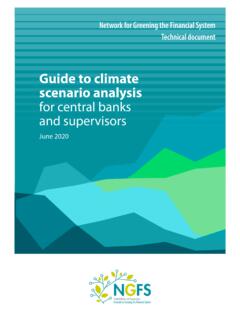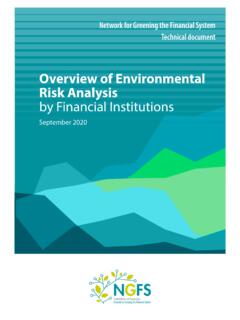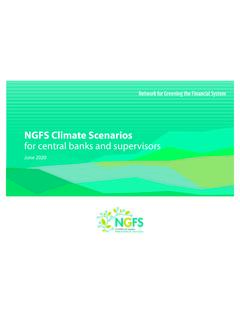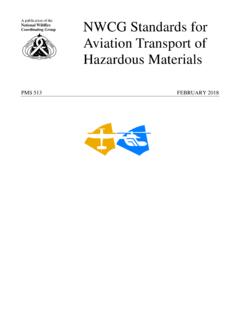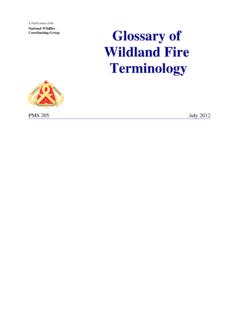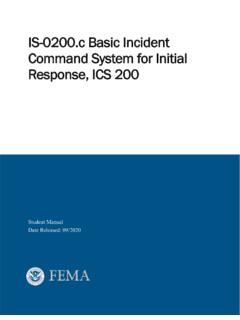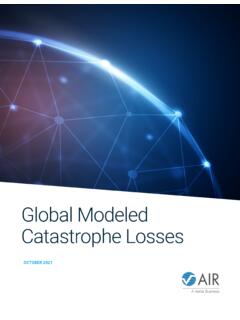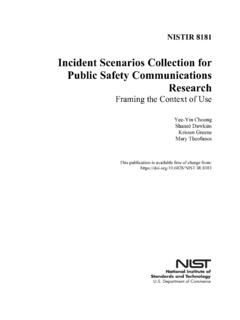Transcription of Climate-related litigation: Raising awareness about a ...
1 Network for Greening the Financial System Technical documentClimate-related litigation: Raising awareness about a growing source of riskNovember 2021 NGFS REPORT2It is my great pleasure to present this document entitled Climate-related litigation: Raising awareness about a growing source of risk .Precisely in these days, at the COP26 in Glasgow, leaders from across the globe gather to find ways to address one of the greatest challenges of our time: achieving global net zero by mid-century and keeping the goal of limiting global average temperature increases to degrees within addition to these efforts by politicians, civil society plays an important role in the fight against climate change. One avenue that is increasingly being pursued relates to climate litigation against public and private actors not convincingly supporting the climate change has been an exceptional year for such Climate-related litigation. Indeed, both the German Constitutional Court and the French Council of State (Conseil d Etat) decided, in essence, that the German and French governments, respectively, are not doing enough to combat climate change.
2 In the Netherlands, a court of first instance ruled that the oil and gas company Royal Dutch Shell has to cut its greenhouse gas emissions by 45% by 2030 to align its policies with the Paris Agreement. 2021 was also the year when the first Climate-related case we are aware of was brought against a central These are just a few examples of judicial control in this rapidly evolving field of law; in fact, the number of cases brought to court has accelerated across the the risks arising from Climate-related litigation is also crucial for central banks and supervisory authorities, as the financial implications of such cases can be substantial. The purpose of this document, based on work conducted this year by the NGFS Legal Task Force on Climate-related litigation, is to raise attention to the risks ensuing from Climate-related litigation, as they are relevant for microprudential supervision and for the monitoring of financial stability. The document outlines general trends in Climate-related litigation and proposes ways of addressing these risks.
3 It has a section on Climate-related litigation risk as a sub-category of physical and transition risks and also briefly discusses the direct exposure of financial institutions to Climate-related litigation. It includes an overview of selected cases as well as the results of a survey that was conducted amongst NGFS members to gather information from the respective jurisdictions about Climate-related sincerely hope that this document can provide a first overview about this fast-moving topic, the importance of which, in my opinion, will only further increase in the coming years. Hence, litigation risk will definitely remain an important subject in the work of the ClientEarth v NBB (pending).Frank EldersonChair of the NGFSF orewordNGFS Climate-related litigationin the context of Climate-related financial risks5 Climate-related litigation risk as a sub-category of physical and transition The direct exposure of financial institutions to Climate-related trends in Climate-related the risks associated with Climate-related I Examples of recent Climate-related litigation11 ANNEX II Bibliography14 ANNEX III NGFS Legal Task Force Survey results15 Table of ContentsNGFS REPORT4 Climate change is one of the biggest global challenges of our time.
4 It may eventually, but irreversibly, lead to an uninhabitable To avoid catastrophic impacts of climate change, the Paris Agreement establishes a climate mitigation goal of keeping global average temperature increases to well below 2 C, preferably C, and requires its parties to submit, and periodically update, national climate mitigation targets ( Nationally Determined Contributions - NDCs) expected to reflect a party s highest possible ambition . According to the latest report of the Intergovernmental Panel on Climate Change (IPCC), global surface temperature will continue to increase until at least the mid-century under all emissions scenarios Even if the world is successful in limiting global warming to below 2 C, there are robust differences in terms of climate impacts between limiting global warming to C or between C and 2 C above pre-industrial These include increases in mean temperature in most land and ocean regions, increases in the frequency and intensity of hot extremes, marine heatwaves, heavy precipitation in several regions, and the probability of drought and precipitation deficits in some regions as well as reductions in Arctic sea ice, snow cover and The 2018 IPCC report also predicts impacts on biodiversity and ecosystems, including species loss and extinction, as well as Climate-related risks to health, livelihoods, food security, water supply, human security, and economic this scientific background, the urgency of having to dramatically reduce greenhouse gas emissions.
5 And a perceived lack of sufficient climate action and ambition around the globe, NGOs and individuals are increasingly 1 Cf. for instance: Eun-Soon Im, Jeremy S. Pal, Elfatih A. B. Eltahir, Deadly heat waves projected in the densely populated agricultural regions of South Asia, Science Advances, August 2017, Volume 3, No 8: Previous work has shown that a wet-bulb temperature of 35 C can be considered an upper limit on human survivability. On the basis of [..] climate change simulations, we project that extremes of wet-bulb temperature in South Asia are likely to approach and, in a few locations, exceed this critical threshold by the late 21st century under the business-as-usual scenario of future greenhouse gas emissions. 2 IPCC Report Climate Change 2021: The Physical Science Basis: Summary for Policymakers, at p. IPCC Special Report 2018: Global Warming of C: Summary for Policymakers, at p. 7 et IPCC 2021 Report, at p. 20; IPCC 2018 Report, at p. 7 et The UNEP Global Climate Litigation Report: 2020 Status Review, at p.
6 6, defines climate change litigation as including cases that raise material issues of law or fact relating to climate change mitigation, adaptation, or the science of climate change .6 Breaking the Tragedy of the Horizon climate change and financial stability, speech given by Mark Carney at Lloyd s of London, 29 September to the courts to sue States, governmental authorities, and private entities for failing to take appropriate climate action and hold them accountable for their past actions, for failing to comply with existing climate obligations and regulations, and for their current lack of ambition through Climate-related Such court actions may also be brought against central banks and supervisors. For example, in April 2021, the first Climate-related litigation against a central bank was launched: The NGO ClientEarth initiated proceedings against the Banque Nationale de Belgique (NBB) before the Tribunal of First Instance in Brussels, alleging that the NBB s purchases of corporate bonds under the Corporate Sector Purchase Programme (CSPP), as well as the European Central Bank s (ECB) decision on the implementation of the CSPP violate the European Union (EU) treaties and fundamental rights, as according to the plaintiff neither the ECB nor the NBB took environmental requirements into account (ClientEarth v NBB).
7 Apart from such cases targeting central banks and supervisors directly, the financial risks arising from Climate-related litigation against other actors are substantial. Back in 2015, Bank of England Governor Mark Carney highlighted that risks arising from such litigation are significant, uncertain and non-linear and will only increase as the science and evidence of climate change hardens. 6 Based on the work of the NGFS Legal Task Force, this document discusses the implications of this rise in Climate-related litigation and the ensuing risks for microprudential supervision and financial stability monitoring. 1. IntroductionNGFS Climate-related litigation risk as a sub-category of physical and transition risksIn its 2019 report A call for action , the NGFS presented and discussed the Climate-related physical risks and transition risks that could affect economic and financial risks cover the economic effects of both acute Climate-related events ( heatwaves, floods, hurricanes and wildfires) and chronic impacts of climate change ( rise in temperatures, sea levels rise and changes regarding precipitation).
8 Acute Climate-related events can impair or destroy asset values, and increase underwriting risks for insurers, possibly leading to lower insurance coverage in some regions. On the other hand, the chronic impacts of climate change will require a significant level of investment and adaptation from companies, households, and governments to prevent losses of revenue and capital risks relate to the process of adjustment towards a low-carbon economy, including the introduction of policy and regulation measures, developments in technology, and changed consumer preferences. Transition risks affect the profitability of businesses and the wealth of households, creating financial risks for lenders and investors. They also affect the broader economy through investment, 7 NGFS, First Comprehensive Report, A call for action: Climate change as a source of financial risk, April NGFS, Climate Scenarios for central banks and supervisors, June 2021, at p. An asset is stranded where infrastructure has to be retired before the end of the asset s useful life in order to meet emission reduction targets.
9 This leads to a fall in value of the assets, resulting in losses to both capital and income for owners and increased market and credit risks for lenders and investors. See NGFS, First Comprehensive Report, at p. 16 et NGFS, Climate Scenarios, at p. See Joana Setzer and Catherine Higham, LSE Report: Global trends in climate change litigation: 2021 snapshot, at p. 28 et and relative price channels, particularly if the transition leads to stranded assets or , 10 In general, both physical and transition risks are therefore understood as potentially having an impact on counterparties and/or physical and transition risks can and do exist by themselves, these risks can be exacerbated by Climate-related litigation. Regarding physical risks, litigation may be brought against an entity alleged to be (indirectly or directly) responsible for a Climate-related extreme event/impact. In the context of climate change, such liability can arise through different routes: The adverse event/impact may be directly attributed to the action (or inaction) of a corporation, government, or other entity.
10 This is the case, for example, if a company is held responsible for directly starting a wildfire which, on the other hand, climate change made more probable. However, sometimes, the action is further removed from the impact. For instance, in the case of Lliuya v RWE AG that is currently pending before German civil courts, the plaintiff, a Peruvian farmer, alleges that the utilities company RWE s emissions are partially responsible for the dangerously high-water levels in the farmer s proximity due to melting mountain glaciers. Similar cases have been brought in the United States and New 2. Understanding Climate-related litigation in the context of Climate-related financial risksNGFS REPORT6 The most common avenue of Climate-related litigation to date relates to transition risks. Some examples are included in Annex I. First, this covers cases brought against states, companies, or other entities on the basis of their failure to take sufficient action to reduce greenhouse gas emissions as mandated by (newly introduced) national laws or international agreements.




